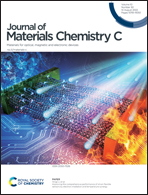Imine bond orientation manipulates AIEgen derived Schiff base isomers through the intramolecular hydrogen bond effect for different fluorescence properties and applications†
Abstract
Precise control of the fluorescence properties of Schiff bases, including luminescence activity and sensing ability, for applications in a particular field remains challenging. In this work, we present a strategy for the design of functional fluorescent Schiff bases based on intramolecular hydrogen bonding in molecules. Three pairs of Schiff base isomers, distinguished by the orientation of C![[double bond, length as m-dash]](https://www.rsc.org/images/entities/char_e001.gif) N, are rationally designed and synthesized by regulating the position of aggregation-induced emission luminogens (AIEgens) and phenol groups on C
N, are rationally designed and synthesized by regulating the position of aggregation-induced emission luminogens (AIEgens) and phenol groups on C![[double bond, length as m-dash]](https://www.rsc.org/images/entities/char_e001.gif) N. Schiff bases with AIEgens on the N side and the phenol group on the C side possess intramolecular hydrogen bonds, exhibiting AIE characteristics, and thus can be applied to the fabrication of light-emitting devices. When the two groups are interchanged, the resulting Schiff bases without intramolecular hydrogen bonds are characterized by fluorescence inactivity in the aggregate and solid state but show intelligent functions that can simultaneously detect and discriminate two different metal ions through distinctly different luminescence light-up. The C
N. Schiff bases with AIEgens on the N side and the phenol group on the C side possess intramolecular hydrogen bonds, exhibiting AIE characteristics, and thus can be applied to the fabrication of light-emitting devices. When the two groups are interchanged, the resulting Schiff bases without intramolecular hydrogen bonds are characterized by fluorescence inactivity in the aggregate and solid state but show intelligent functions that can simultaneously detect and discriminate two different metal ions through distinctly different luminescence light-up. The C![[double bond, length as m-dash]](https://www.rsc.org/images/entities/char_e001.gif) N orientation-inverted congeners with dramatically different fluorescence properties are structurally similar. This work provides insights for in-depth understanding of the structure–property relationships of Schiff bases.
N orientation-inverted congeners with dramatically different fluorescence properties are structurally similar. This work provides insights for in-depth understanding of the structure–property relationships of Schiff bases.



 Please wait while we load your content...
Please wait while we load your content...